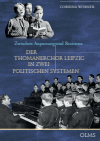Zusammenfassung
Johann Sebastian Bach war sowohl im Nationalsozialismus als auch in der DDR eine Projektionsfläche ideologisch geprägter Kulturpolitik. Künstler dienten im Werben um die politische Legitimation beider Regime als Propagandainstrument. Als Kulturbotschafter zweier Diktaturen bewegten sich die Thomaskantoren Karl Straube, Günther Ramin, Kurt Thomas und Erhard Mauersberger mit den Thomanern auf einem schmalen Grat zwischen Kunstfreiheit und politischer Doktrin. Sie agierten dabei im Spannungsfeld zwischen künstlerischen Eigeninteressen und politischer Instrumentalisierung. Der Thomanerchor war weder ein Hort gänzlicher Anpassung noch ausgesprochenen Widerstands, vielmehr dominierten Grautöne. Beide politischen Systeme wollten die kirchlichen Bindungen eliminieren. Trotz hohen Konfliktpotenzials gab diese im Kern kein Thomaskantor preis; sie waren nicht verhandel-, wohl aber anpassbar. Im Rahmen eines sektoralen Diktaturvergleichs wird anhand exemplarischer Themenkreise, welche den gesamten Untersuchungszeitraum prägen, kirchliches und weltliches Arbeitsfeld, Repertoire sowie Sozial- und Organisationsstruktur umfassend untersucht. Mittels qualitativer und quantitativer Methoden werden die unterschiedlichen Perspektiven handelnder Akteure und Institutionen im NS- und SED-Staat differenziert aufgezeigt.
Abstract
Johann Sebastian Bach was a projection screen for ideologically shaped cultural policy under both National Socialism and the GDR. Artists served as propaganda instruments in both regimes' efforts to gain political legitimacy. As cultural ambassadors of two dictatorships, the Thomaskantors Karl Straube, Günther Ramin, Kurt Thomas and Erhard Mauersberger, together with the Thomaner, walked a fine line between artistic freedom and political doctrine. They operated in the area of tension between artistic self-interest and political instrumentalization. The St. Thomas Boys' Choir was neither a place of complete conformity nor of outright resistance; rather, shades of gray dominated. Both political systems wanted to eliminate ecclesiastical ties. Despite a high potential for conflict, no St. Thomas Cantor revealed these in essence; they were not negotiable, but adaptable. Within the framework of a sectoral comparison of dictatorships, ecclesiastical and secular fields of work, repertoire, and social and organizational structure are comprehensively examined on the basis of exemplary thematic areas that characterize the entire period under investigation. By means of qualitative and quantitative methods, the different perspectives of actors and institutions in the Nazi and SED states are shown in a differentiated way.n)
Schlagworte
DDR Kulturpolitik Leipzig NS-Diktatur NS-Staat Thomaner Thomanerchor- 11–12 Vorwort 11–12
- 13–40 I. Einleitung 13–40
- 699–700 X. Abbildungsverzeichnis 699–700
- 701–702 XI. Tabellenverzeichnis 701–702
- 705–726 XIII. Index 705–726

